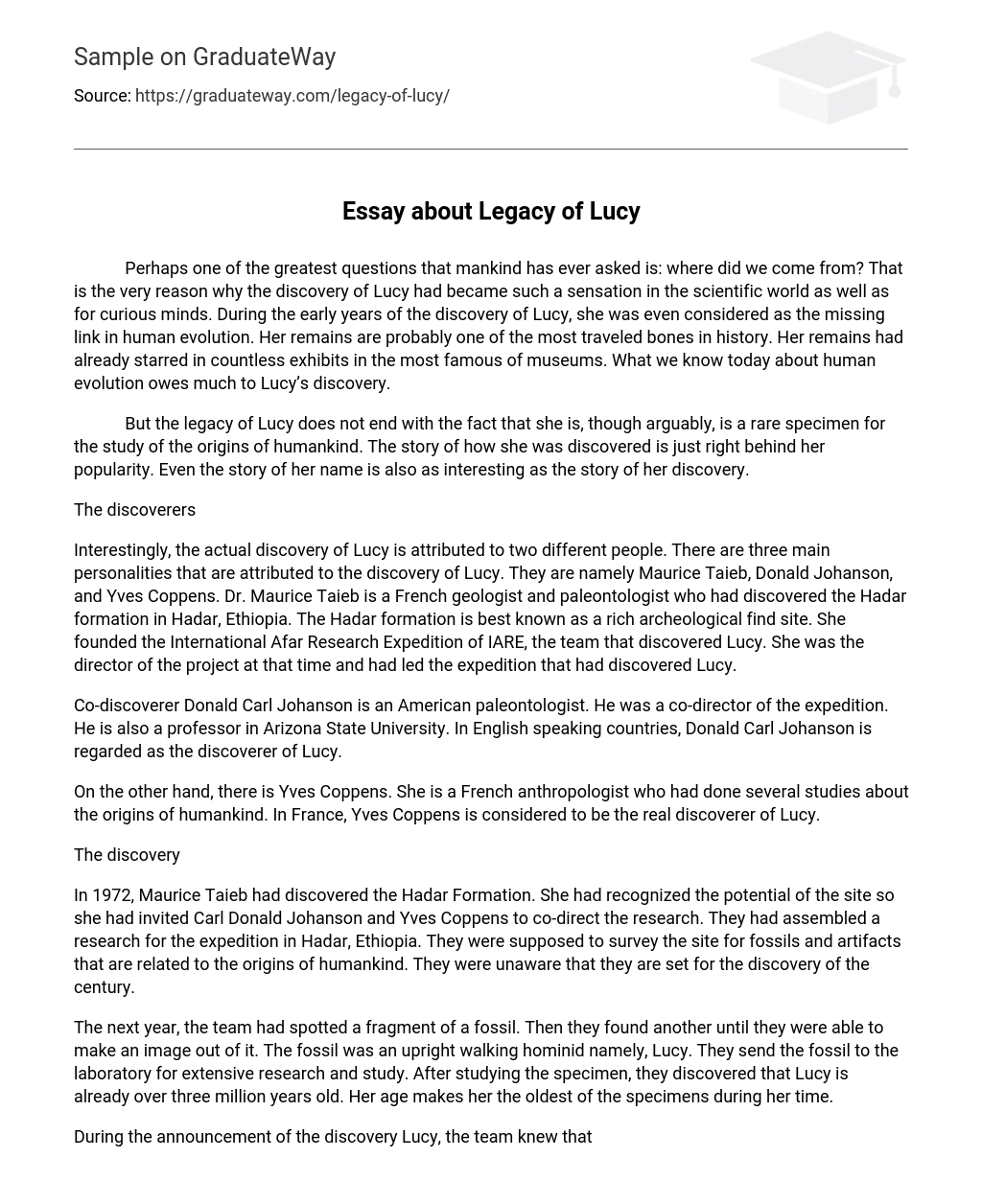Perhaps one of the greatest questions that mankind has ever asked is: where did we come from? That is the very reason why the discovery of Lucy had became such a sensation in the scientific world as well as for curious minds. During the early years of the discovery of Lucy, she was even considered as the missing link in human evolution. Her remains are probably one of the most traveled bones in history. Her remains had already starred in countless exhibits in the most famous of museums. What we know today about human evolution owes much to Lucy’s discovery.
But the legacy of Lucy does not end with the fact that she is, though arguably, is a rare specimen for the study of the origins of humankind. The story of how she was discovered is just right behind her popularity. Even the story of her name is also as interesting as the story of her discovery.
The discoverers
Interestingly, the actual discovery of Lucy is attributed to two different people. There are three main personalities that are attributed to the discovery of Lucy. They are namely Maurice Taieb, Donald Johanson, and Yves Coppens. Dr. Maurice Taieb is a French geologist and paleontologist who had discovered the Hadar formation in Hadar, Ethiopia. The Hadar formation is best known as a rich archeological find site. She founded the International Afar Research Expedition of IARE, the team that discovered Lucy. She was the director of the project at that time and had led the expedition that had discovered Lucy.
Co-discoverer Donald Carl Johanson is an American paleontologist. He was a co-director of the expedition. He is also a professor in Arizona State University. In English speaking countries, Donald Carl Johanson is regarded as the discoverer of Lucy.
On the other hand, there is Yves Coppens. She is a French anthropologist who had done several studies about the origins of humankind. In France, Yves Coppens is considered to be the real discoverer of Lucy.
The discovery
In 1972, Maurice Taieb had discovered the Hadar Formation. She had recognized the potential of the site so she had invited Carl Donald Johanson and Yves Coppens to co-direct the research. They had assembled a research for the expedition in Hadar, Ethiopia. They were supposed to survey the site for fossils and artifacts that are related to the origins of humankind. They were unaware that they are set for the discovery of the century.
The next year, the team had spotted a fragment of a fossil. Then they found another until they were able to make an image out of it. The fossil was an upright walking hominid namely, Lucy. They send the fossil to the laboratory for extensive research and study. After studying the specimen, they discovered that Lucy is already over three million years old. Her age makes her the oldest of the specimens during her time.
During the announcement of the discovery Lucy, the team knew that they were up for a tremendous task as this could be the one of the greatest discoveries in history. Even the planning alone was so carefully and meticulously done that the team had to prepare for three weeks. But even if the work was enormous the morale of the team was high.
In the site where Lucy lay, they were able to gather only forty-seven bones of skeleton. Those forty-seven pieces of bones had only translated to only forty percent of the original skeletal frame of Lucy. Fortunately, it was enough to roughly reconstruct for further studies.
Later studies had confirmed that Lucy is a female. Her frame was relatively smaller to males of the same specie. When her skeleton was reconstructed, it was assumed that she would have only stood at three and a half feet tall. Her approximated body mass was only between sixty and sixty-five pounds.
Her discovery was one of the most important indeed as even up to this day, Lucy remains as the oldest and yet most complete in terms of bones that was retrieved from the Africa, where humankind had supposedly originated. (Johanson, 1981)
The name
Lucy is formally known as the fossil that was given the code AL 288-1. She was also given a second in the Amharic language which was “Dingines” or “Dinkenesh.” The Amharic name of Lucy translates to “you are beautiful” or “you’re a wonderful” (The Houston Museum of Natural Science).
The team that had discovered Lucy was in high spirits when they had found her. That is just understandable as her fossil really is an immense discovery that could lead us to a better understanding of who we are as living beings. In one night, the team had celebrated at the camp site. There was a song by the Beatles that was repeatedly playing loudly. The song was entitled “Lucy in the Sky with Diamonds.” That is where the fossil coded AL 288-1 got its nickname, Lucy.
Work Cited
Ciochon, Russell L. & Fleagle. Primate Evolution and Human Origins.
CA: Aldine Transaction. 1987
Johanson, Donald & Maitland Edey. Lucy, the Beginnings of Humankind. Granada. 1981
The Houston Museum of Natural Science. Lucy’s legacy: Discovering our most famous ancestor.
Retrieved 9 May 2008 <http://lucyexhibition.com/lucys-discovery.aspx>





